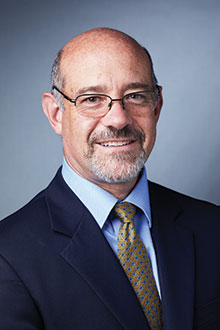FDA Advisory Panel Clears Way for Likely Approval of Intranasal Esketamine
Abstract
Still to be determined is if intranasal esketamine might be effective in rapidly resolving suicidal ideation, closely linked with the risk of suicide.
An independent advisory panel to the Food and Drug Administration (FDA) last week endorsed the esketamine nasal spray Spravato for the treatment of adults with treatment-resistant depression.

Gerard Sanacora, M.D., Ph.D., says the vote by the FDA panel on esketamine could prove an important advance for patients with depression who have not responded to standard treatments.
Esketamine is a purified form of ketamine that only includes only one version of the ketamine molecule. Esketamine can be administered intranasally in relatively small doses to deliver a very rapid therapeutic effect (ketamine itself has been in use since 1970 as an anesthetic). Spravato was developed by the Janssen Pharmaceutical Companies of Johnson & Johnson.
In a 14-2 vote with one abstention, the Psychopharmacologic Drug Advisory Committee and Drug Safety and Risk Management Advisory Committee concluded the benefits of esketamine outweigh the risks.
While the FDA is not required to follow the recommendation of the panel, the agency does take its advice into consideration. A decision by the FDA on whether to approve the medication is expected by March 4.
Gerard Sanacora, M.D., Ph.D., a professor of psychiatry at Yale University School of Medicine, said the advisory panel vote represented “an overwhelming endorsement.” He was the lead author of a consensus statement on ketamine for the treatment of depression and suicide developed in 2017 by a work group of the APA Council on Research Task Force on Novel Biomarkers and Treatments.
“I think it’s an extremely positive and potentially very important advance for patients who have not responded to standard treatments, and those who may require a treatment with a very rapid onset,” Sanacora told Psychiatric News. “The one set of patients who are likely to gain the most immediate benefit are those whose depression has reached a point of severity where they are considering hospitalization. It’s possible that this type of treatment could prevent hospitalization or shorten the stay.”
Sanacora also coauthored a proof-of-concept study, which was published in the American Journal of Psychiatry in April 2018. The study found that when patients at high risk of suicide were given intranasal esketamine in addition to comprehensive standard-of-care treatment, they experienced significant improvement in depressive symptoms compared with those who received placebo. These improvements included on some measures of suicidal ideation.
Sanacora told Psychiatric News that ongoing phase 3 trials may yield data on whether esketamine might be effective in treating depressed patients experiencing suicidal ideation and possibly even preventing suicide. “The most immediate goal of further research is to gather more information on the benefits of intranasal esketamine in patients with suicidal thinking,” he said. “If we can rapidly reduce suicidal ideation, which is closely tied to the risk of suicide, that would be an enormous clinical advance.”
As described in background materials made available on the FDA website ahead of the meeting, the evidence in support of esketamine’s effectiveness derives primarily from two positive phase 3 trials, which showed that treatment with esketamine nasal spray plus a newly initiated oral antidepressant was associated with rapid reduction of depressive symptoms and delayed time to relapse of symptoms of depression compared with placebo nasal spray plus a newly initiated antidepressant.
The safety profile of esketamine was evaluated in both short- and long-term trials, which concluded that the medication was generally tolerable in patients with treatment-resistant depression. The most common adverse events reported by patients in the trials included sedation, dissociation, and increases in blood pressure, with the symptoms most commonly presenting in the two hours following drug administration.
Because esketamine is a similar compound to ketamine—a popular recreational drug that produces “out-of-body” experiences and hallucinations—some experts have expressed concerns about the risks of misuse and abuse. In briefing materials submitted by Janssen ahead of the advisory committee meeting, the company stated that no evidence of abuse, misuse, or overdose was observed in the esketamine development program with a treatment-resistant depression population, and possible diversion was minimal. (Less than 0.1 percent of the clinical supply kits were unaccounted for in the phase 3 studies, according to the company.)
The FDA is proposing a Risk Evaluation and Mitigation Strategy (REMS) to ensure safe use of esketamine. “Among the key elements of the proposed REMS, esketamine administration would occur only in certain health care settings where the patient could be monitored for two hours after administration, the drug would not be dispensed directly to patients, and patients would be enrolled in a registry to better characterize the risks associated with esketamine administration,” the FDA briefing document noted.
Sanacora said that physicians, the FDA, and the pharmaceutical industry recognize the risks associated with the drug and have established safeguards to prevent abuse and diversion. “I think it is important that people are acknowledging the potential risk,” he said.
He added that in addition to the possible effect of esketamine on suicidal thinking, another important issue still be determined by research is the ideal patient population for treatment with the agent. For instance, a crucial question is whether esketamine would be safe for use in patients with comorbid psychotic symptoms; in most studies those patients have been excluded.
“When we are talking about patients with severe depression and those with imminent risk for suicide, it is not uncommon to have comorbid psychotic features,” he said. “Theoretically, esketamine might be a replacement or alternative to ECT [electroconvulsive therapy], so it will be important to know if this treatment is safe in that population, as well as in patients with bipolar disorder.”
Sanacora added, “This is an extremely exciting new treatment option, but we really have to understand the risks, optimize the benefits, and advance this treatment in a responsible fashion.” ■



